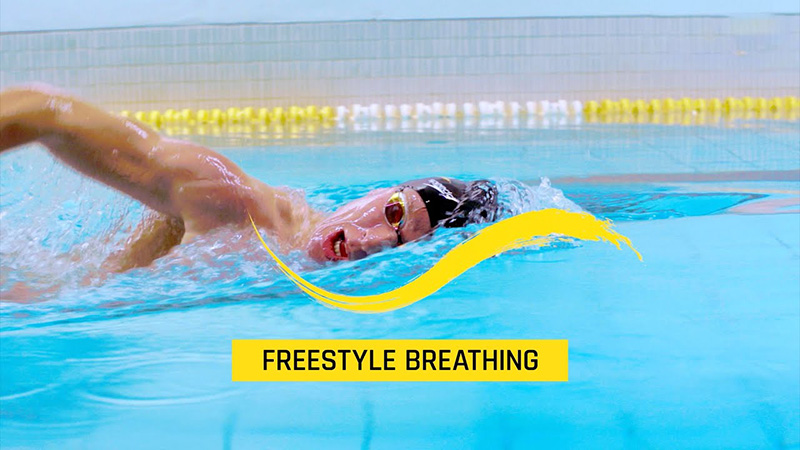Learning how to breathe properly when swimming freestyle is just as important as learning the basic strokes themselves if you want to maximize your performance and minimize tiredness. In this blog, Swim Time Log will be covers the freestyle swimming breathing essential abilities, common challenges, and effective exercises needed to achieve freestyle swimming breathing.
The importance of proper breathing in freestyle swimming
Proper breathing in freestyle swimming is essential for several reasons:
- Oxygen intake: Efficient breathing ensures a continuous supply of oxygen to the muscles, enabling them to work harder and longer.
- Reduced drag: A streamlined head position and controlled breathing minimize disruption to the water flow, reducing drag and enhancing overall efficiency.
- Improved rhythm and timing: Proper breathing synchronizes with the arm and leg movements, maintaining a steady rhythm and preventing disruptions in the stroke pattern.
- Reduced fatigue: Efficient breathing minimizes energy expenditure and prevents breathlessness, allowing swimmers to swim for longer distances without fatigue.

In Freestyle Swimming, Breathing is Very Important
And mastering freestyle breathing techniques offers a myriad of benefits, including:
- Enhanced performance: Improved breathing efficiency leads to increased speed, endurance, and overall stroke performance.
- Reduced fatigue: Proper breathing techniques minimize energy expenditure, allowing swimmers to swim for longer distances without becoming breathless.
- Smoother swimming experience: A relaxed and efficient breathing pattern contributes to a smoother and more enjoyable swimming experience.
- Reduced risk of injuries: Proper breathing technique helps maintain a streamlined body position, minimizing strain on the neck and shoulders.
Basics of Freestyle Swimming Breathing
Overview of the Freestyle Swimming

The Overview Of Freestyle Swimming
Freestyle swimming, also known as front crawl, is a fundamental stroke characterized by alternating arm movements, a flutter kick, and a rhythmic breathing pattern. It is a versatile and efficient stroke, suitable for a wide range of swimming distances and fitness levels.
In freestyle swimming, breathing typically occurs during the recovery phase of the arm cycle, when one arm is lifted out of the water and the head can rise for a quick breath. However, coordinating breathing with arm movements can be challenging, as it requires precise timing and a streamlined head position to minimize disruption to the stroke pattern.
Fundamental Freestyle Swimming Breathing Techniques
Breath timing, rhythm, and head position

Trickle Breathing Could Be an Option to Train Your Breathing Technique
- Breath timing: Initiate the breath as your arm starts to recover from the water.
- Rhythm: Develop a breathing rhythm that matches your stroke pace.
- Head position: Lift your head quickly to take a shallow breath and submerge it immediately after.
Drills and Exercises for Improved Freestyle Swimming Breathing

You Can Use Various Drills to Improve your Lung Capacity
Exercises to improve lung capacity and technique efficiency:
- Interval training: Alternate between high-intensity freestyle swimming and periods of rest to build endurance and improve lung capacity.
- Breathing exercises: Incorporate breathing exercises, such as diaphragmatic breathing and pursed-lip breathing, to strengthen your respiratory muscles and improve lung control.
- Cardiovascular exercises: Engage in cardiovascular activities, such as running or cycling, to improve overall fitness and endurance, which can translate to improved breathing efficiency in swimming.
Conclusion
Mastering freestyle swimming and breathing require dedication, practice, and proper technique. By following the guidelines, you can develop efficient breathing habits, improve your lung capacity, and elevate your overall performance. Embrace the challenge, practice consistently, and seek guidance when needed. With effort and perseverance, you can overcome breathing challenges and experience the joy of swimming freestyle with ease and confidence.
Read more:
- Learn Butterfly Swimming Step by Step
- The Art of Butterfly Swimming: Understanding the Stroke Cycle
- Refining Front Crawl with the Butterfly Swim Style
AUTHOR
Sang Nguyen
Sang Nguyen is a former national swimmer for Vietnam who has transitioned into coaching. With a passion for fostering a healthy swimming community and connecting like-minded individuals,......Read More
BLOG
Maybe You Are Interested
Nutrition for Swimmers Guide: Maximizing Performance
Swimming demands not only physical prowess but also a strategic nutritional approach to maximize performance....
Crafting a Nutrition Plan for Competitive Swimmers
In the competitive world of swimming, nutrition plays a pivotal role in an athlete’s performance...
A Comprehensive Guide to Maximum Performance Nutrition for Swimmers
Swimming is not just about technique and training; nutrition plays a pivotal role in a...
Essential Swim Nutrition Tips for Peak Performance
Swimming is a highly demanding sport, requiring a combination of technique, strength, and endurance. But...
Expert Sports Nutrition Advice for Swimmers
In the competitive world of swimming, nutrition and training are as crucial as the technique...
The Synergy of Swimming and Nutrition: Balancing Intake for Optimal Water Performance
The Synergy of Swimming and Nutrition: Balancing Intake for Optimal Water Performance dives into the...